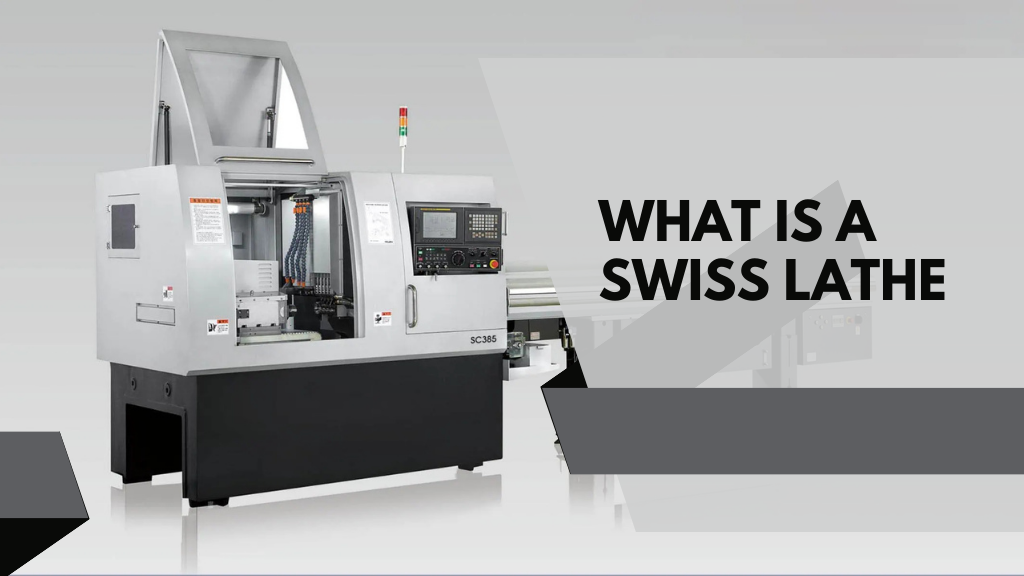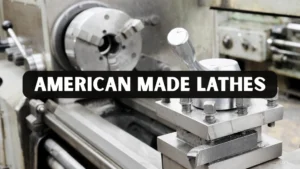In the world of modern manufacturing, accuracy, speed, and efficiency determine the success of machining operations. Among the many advanced machine tools available today, the Swiss lathe stands out as one of the most versatile and precise. Originally invented in Switzerland during the late 19th century, this specialized lathe has evolved into an essential tool for producing complex, small, and high-precision parts across industries such as aerospace, medical devices, electronics, and automotive.
This guide provides a comprehensive look at Swiss lathes, including their history, functions, advantages, differences from traditional lathes, and practical applications. By the end of this article, you will understand not only what a Swiss lathe is but also why it remains one of the most accurate machining solutions available today.
What is a Swiss Lathe
A Swiss lathe, also known as a Swiss-type lathe or sliding headstock lathe, is a machine tool designed for high-precision turning. Unlike traditional lathes where the workpiece is held stationary in a chuck while tools move against it, a Swiss lathe operates by feeding the material through a guide bushing. This design allows the cutting tool to always work very close to the support point, reducing deflection and vibration.
Swiss lathes are especially effective for long, slender, and small-diameter parts. They can handle intricate geometries that would be difficult or impossible to produce consistently on a conventional lathe.
Key characteristics of Swiss lathes include:
- Guide bushing support: Keeps the workpiece rigid during cutting.
- Sliding headstock: Moves material through the guide bushing for consistent machining.
- Multi-axis capability: Often supports up to 10 or more axes for complex part geometry.
- Automatic bar feeder integration: Enables continuous machining of parts from bar stock.
This unique configuration makes the Swiss lathe ideal for high-volume production of tight-tolerance components.
Why is it Called a Swiss Machine
The name Swiss machine comes from the country of origin. Swiss-type lathes were first developed in Switzerland in the late 1800s to manufacture precision watch components. Watchmaking required incredibly small, detailed, and accurate parts, and the conventional lathes of that era could not meet the demands.
The Swiss engineering tradition emphasized precision and craftsmanship, which led to the creation of the sliding headstock mechanism and guide bushing system. This innovation allowed machinists to cut with unprecedented accuracy and consistency. Over time, the technology spread to other sectors such as medical instruments and aerospace manufacturing.
Today, even though these machines are produced globally, the term Swiss lathe or Swiss-type lathe remains as a tribute to their origin in Switzerland’s watchmaking industry.
Types of Swiss Lathes
Over time, manufacturers have developed several types of Swiss lathes to accommodate different production requirements. While all share the sliding headstock concept, their configurations vary.
-
Sliding Headstock Swiss Lathe
The most traditional design. Bar stock moves through a guide bushing, and cutting occurs close to the support point. This minimizes vibration and is ideal for long, thin components.
Best for: Medical screws, shafts, watch components, and fine connectors.
-
Non-Guide Bushing Swiss Lathe
This design eliminates the guide bushing, operating more like a conventional CNC lathe. It reduces bar waste and is better for shorter parts.
Best for: Components under three times the bar diameter in length, larger diameters, and parts requiring less material waste.
-
CNC Swiss Lathe
The most common type today. CNC Swiss lathes integrate advanced computer controls, multiple axes, live tooling, and sub-spindles. They can perform turning, milling, drilling, and tapping simultaneously, reducing the need for multiple setups.
Best for: Complex geometries requiring multiple machining processes in one cycle.
-
Hybrid Swiss Lathe
A hybrid model allows operators to switch between guide bushing and non-guide bushing modes. This provides flexibility for shops that produce both long, thin parts and shorter components.
Best for: Manufacturers handling a variety of part sizes and shapes.
-
Multi-Spindle Swiss Lathe
Equipped with multiple spindles, these machines can produce several parts at once, drastically increasing throughput. While less common, they are highly efficient for large-scale production.
Best for: Automotive connectors, aerospace fasteners, and electronics components in bulk.
What is the Difference Between a Swiss Lathe and a Traditional Lathe
Understanding the differences between a Swiss lathe and a traditional lathe is essential for determining which machine best suits a particular application.
Workpiece Support
- Swiss Lathe: Uses a guide bushing to support the workpiece very close to the cutting tool, minimizing deflection.
- Traditional Lathe: Holds the workpiece in a chuck or collet at one end, which can cause deflection in long or thin parts.
Part Geometry
- Swiss Lathe: Specializes in small, slender, complex, and intricate parts.
- Traditional Lathe: Suitable for larger and less complex components.
Machining Speed
- Swiss Lathe: Highly efficient for long production runs, especially with automatic bar feeders.
- Traditional Lathe: Effective for short runs, larger parts, and simpler operations.
Tooling and Complexity
- Swiss Lathe: Often has multiple tool stations, including live tooling, enabling simultaneous milling, drilling, and turning.
- Traditional Lathe: Typically supports fewer tools and simpler operations.
Setup and Programming
- Swiss Lathe: More complex programming and setup due to multiple axes and tool coordination.
- Traditional Lathe: Easier to program and set up, making it beginner-friendly.
In short, the Swiss lathe excels at precision, small part production, and high-volume efficiency, while traditional lathes are better for large, simple, and low-volume components.
Are Swiss Lathe Accurate
Yes, Swiss lathes are among the most accurate machine tools available in modern manufacturing. Their unique design with a sliding headstock and guide bushing minimizes deflection and vibration, which are the primary causes of inaccuracy when machining slender or complex parts. By keeping the cutting action extremely close to the support point, Swiss lathes can maintain tolerances as tight as just a few microns.
Factors That Influence Accuracy
The precision of a Swiss lathe depends on several elements:
- Machine build quality: High-end Swiss lathes from reputable manufacturers maintain rigidity and thermal stability for long production runs.
- Tooling selection and condition: Sharp, properly balanced tools ensure consistent surface finishes and accuracy.
- Operator expertise: Skilled programming, correct speeds and feeds, and proper alignment improve performance.
- Environmental control: Temperature and vibration control in the workshop contribute to micron-level accuracy.
Industries That Rely on Accuracy
Because of this unmatched precision, Swiss lathes are widely used in industries where failure is not an option:
- Medical device manufacturing: Surgical screws, orthopedic implants, dental instruments, and catheter components demand flawless repeatability.
- Watchmaking and jewelry: Miniature gears, shafts, and decorative parts require both functionality and aesthetic perfection.
- Aerospace and defense: Lightweight fasteners, engine parts, and electrical connectors must meet strict international standards.
- Electronics: Pins, micro housings, and connectors require extremely tight tolerances to ensure proper fit and conductivity.
Repeatability and High-Volume Consistency
Another strength of Swiss lathes is their repeatability. They are capable of producing thousands or even millions of identical parts with virtually no variation. This makes them the machine of choice for industries where long production runs are the norm and consistent quality is critical.
In short, if accuracy, repeatability, and consistency are your priorities, a Swiss lathe delivers superior precision compared to traditional CNC lathes and remains one of the best investments in modern machining.
Advantages of Swiss Lathe
Swiss lathes offer a wide range of benefits, making them essential for high-precision industries.
-
Exceptional Accuracy
One of the most notable advantages of Swiss lathes is their ability to deliver exceptional accuracy. These machines are capable of achieving tolerances within a few microns, making them highly reliable for precision-driven industries. This level of accuracy is critical when manufacturing parts for medical devices, aerospace instruments, and electronic components. With consistent precision, manufacturers can maintain strict quality standards across all production runs.
-
Efficient Production
Swiss lathes are designed with automated bar feeders that allow continuous machining. This eliminates frequent interruptions and ensures smooth operations even during large-scale production runs. The ability to operate with minimal downtime makes them an excellent choice for companies focusing on efficiency and productivity. As a result, businesses can meet tight deadlines while maintaining a steady workflow.
-
Multi-Function Capability
Unlike conventional lathes, Swiss lathes provide multi-functionality by integrating turning, drilling, milling, and tapping in one machine. This versatility reduces the need for multiple setups, saving both time and labor costs. Manufacturers can complete complex designs in a single process without transferring the part to other machines. The outcome is faster turnaround and a higher level of precision in finished products.
-
Superior Surface Finishes
Another key benefit of Swiss lathes is the high-quality surface finish they produce. Because the workpiece is supported close to the cutting tool, vibrations are significantly reduced during machining. This results in smoother finishes and improved dimensional accuracy. Industries requiring polished and refined surfaces, such as watchmaking or dental tools, rely heavily on this advantage.
-
Compact Part Capability
Swiss lathes are particularly effective at machining small and slender components. Traditional lathes often struggle with maintaining precision on delicate or narrow parts, but Swiss lathes are built for such tasks. Their unique guide bushing system supports the workpiece throughout the process, ensuring stability. This makes them ideal for intricate work such as surgical instruments, miniature connectors, and fine mechanical parts.
-
High-Volume Suitability
For businesses focusing on mass production, Swiss lathes provide unmatched efficiency and consistency. These machines can operate continuously while maintaining precision across thousands of identical components. The ability to deliver consistent results makes them highly valuable in industries where large quantities of parts are required. Additionally, their automation reduces the need for manual adjustments during extended runs.
-
Reduced Secondary Operations
Swiss lathes minimize the need for secondary machining processes by completing complex geometries in a single setup. This not only saves time but also reduces costs associated with rework and additional equipment. By handling detailed shapes and multiple operations at once, these machines improve overall production efficiency. Manufacturers can achieve high-quality parts with fewer steps, boosting profitability and reducing errors.
Disadvantages of Swiss Lathe
While Swiss lathes are highly effective and accurate, they also come with certain drawbacks. These limitations make them less practical in some applications, especially when compared to traditional lathes. Understanding the disadvantages helps manufacturers evaluate when a Swiss lathe is the right investment.
-
High Cost
One of the main disadvantages of Swiss lathes is their high price. Compared to conventional lathes, Swiss machines require a significantly larger investment. The cost includes not only the machine itself but also specialized tooling and bar feeders, which can make them less accessible for small shops or startups.
-
Complex Setup
Swiss lathes demand skilled operators and advanced programming expertise. Setting up these machines is not straightforward, as operators must carefully configure tooling, bar feeders, and programming to achieve precision. This complexity means training costs are higher, and inexperienced machinists may struggle to use them effectively.
-
Not Ideal for Large Parts
Another drawback is that Swiss lathes are not suited for machining large components. Their design focuses on producing small, slender, and highly detailed parts. For manufacturers dealing with heavy or oversized components, traditional CNC lathes or machining centers are usually a better fit.
-
Higher Maintenance Needs
Since Swiss lathes are precision machines, they require careful maintenance to perform at their best. Regular cleaning, lubrication, and inspection of parts are essential to avoid breakdowns. This level of maintenance can increase downtime and costs, making them less convenient for shops that cannot dedicate resources to upkeep.
Real-World Applications of Swiss Lathe
Swiss lathes are used in nearly every industry that requires small, precise, and repeatable parts.
- Medical Devices: Bone screws, dental implants, catheter components.
- Aerospace: Engine fittings, electrical connectors, lightweight bolts.
- Defense: Firearm components, precision fasteners.
- Electronics: Smartphone connectors, circuit board parts, pins.
- Automotive: Fuel injector parts, valve components, precision bearings.
- Watchmaking and Jewelry: Decorative miniature parts, gears, and housings.
Conclusion
The Swiss lathe remains one of the most important innovations in modern machining. Its ability to deliver precision, efficiency, and consistency makes it indispensable for industries ranging from medical devices to aerospace. While the initial investment and complexity are higher than traditional lathes, the advantages far outweigh the challenges for manufacturers that require high-volume precision production.
By understanding what a Swiss lathe is, how it differs from a traditional lathe, why it is called a Swiss machine, and how accurate it can be, businesses and engineers can make informed decisions about whether this machining solution is right for their production needs.
FAQs
What is a Swiss lathe used for
Swiss lathes are primarily used for manufacturing small, precise, and complex parts that require tight tolerances.
Can a Swiss lathe make large parts
No, Swiss lathes are optimized for smaller and slender parts. For large components, traditional lathes or CNC machining centers are more appropriate.
Are Swiss lathes expensive
Yes, they are considered a premium investment due to their precision engineering and capabilities. However, they are cost-effective in the long run for high-volume production.
How accurate is a Swiss lathe compared to a CNC lathe
Swiss lathes generally offer higher accuracy for slender and complex parts compared to standard CNC lathes.




